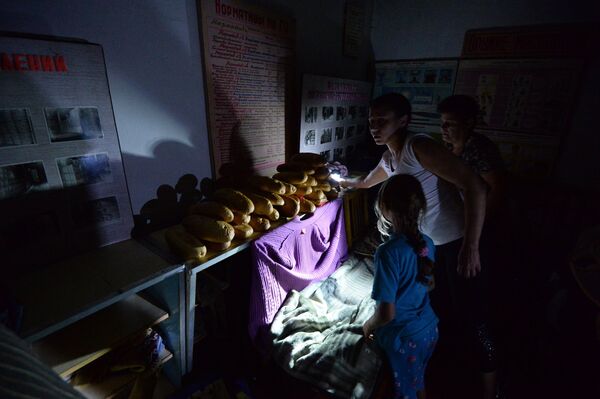HORLIVKA, August 11 (RIA Novosti) - For a whole month now, Horlivka, a small town in the Donetsk region in eastern Ukraine, has been subject to heavy artillery shelling. The assault has already claimed more than 50 lives. The town has almost completely run out of food and medicine. The administration of the local Stirol chemical plant is warning of a potential ecological disaster. A RIA Novosti correspondent managed to catch a glimpse of how the besieged town is struggling to survive.
“WHY SHOULD WE LEAVE?”
Aksyonovka, one of the hotspots on the map of Horlivka, has recently come under a hailstorm of Grad missiles. It is unclear why the Ukrainian military has targeted this particular village. Supposedly, they sought to destroy checkpoints or headquarters set up by self-defense fighters, but there are none anywhere in the vicinity.
Local residents prefer hiding in cellars. Luckily, every family household has one. People don’t mind showing their shelters to reporters: they have mattresses, candles, a stock of canned food, and even books. Those who do not have private cellars use a bomb shelter: the authorities cleaned up and equipped a Soviet-era bomb shelter some time ago.
In Aksyonovka, the basement of a local school has been turned into a shelter. Tamara Ivanovna, aged 78, is slicing a sausage.
“I could not have imagined in my worst nightmare that my children would be the children of war, that we would have to live in cellars,” she says.
Too old to climb up and down the stairs, she prefers staying underground – there will be more shelling anyway. Fortunately, Tamara Ivanovna’s daughter, Tatyana, takes care of her, brings her the things she needs.
“Why don’t you leave?” I ask them.
“At first, we didn’t want to, and now it is too dangerous. And who needs us there? Look, this is our land. Why should we leave?” they reply.
As we talked, the basement filled up with other people: everyone could hear the familiar artillery shell explosions. It’s better to wait.
“What on earth are they doing here? We aren’t bombing Lviv, are we? So let them go home; no one invited them here,” a woman says indignantly.
CHURCHES AND CHEMICAL PLANT UNDER FIRE
Before the “war,” as the locals now call it, Horlivka, an industrial center 47 kilometers (29 miles) northeast of Donetsk, had a population of 360,000. The number of people remaining there now is unclear, but based on the deserted streets, closed offices, factories and shops, and groups of refugees at the bus stations and the lines of outgoing cars – most people have fled or are fleeing.
After 52 civilians, including nine children, were killed and 170 others wounded in the past two weeks, why would they stay? On Sunday, a shell hit the Cathedral of the Epiphany, Horlivka’s main church, during the weekly liturgy just when the Eucharistic Prayer was being read.
It was a twisted quirk of fate for those staying in the cathedral’s basement. On a warm summer day, they climbed out – some to bask in the sun, others to attend the liturgy. Six people were wounded by shrapnel.
“A woman had her hand blown off, a man received shrapnel wounds in the legs and another man was wounded in the head,” a cleric said.
A few days earlier, another church, the Church of the Annunciation, caught fire and burnt down after being struck by a shell.
The administration of Stirol, one of Ukraine’s largest chemical plants, warned that amid continuous shelling “due to the irresponsible actions of the Ukrainian army, the residents of Ukraine, Russia and Belarus are in real danger of an ecological disaster.”
The plant has stockpiles of a lethal substance mononitrochlorobenzene. A potential leak could contaminate a vast area within the radius of 300 kilometers (186 miles). Donetsk, the adjacent parts of Russia and the areas controlled by the Ukrainian troops will all have their share of the trouble.
UNDERGROUND SUN
Another bomb shelter in Horlivla is located next to a mental hospital, where bed-ridden patients are humbly awaiting their destiny. The shelter has electricity and running water, all fixed by the self-defense fighters. There is a shell crater a dozen meters from the entrance.
“The shell was supposed to kill us, but we used it for our needs,” Oksana, a mother of two, says smiling.
The self-defense fighters ran a water line to the crater turning it into an improvised wash basin. So far it has been working. But it’s unclear how well it will work during the fall or, worse, in winter, when it will be cold both inside and outside the shelter.
Oksana lives in the Nikitovsky distict in the north of Horlivka. It is one of the most dangerous areas.
“A piece of shrapnel flew into our room, broke the window and pierced the refrigerator. Then it became clear it was time to leave,” she recalls, looking at her younger son playing a game on a laptop computer with other boys.
“The laptop was the first thing the children grabbed when leaving the flat,” Oksana said.
An ordinary woman, she pities the children most – her own and others: “If a car bangs noisily down the road the children hide as if it were a bomb.”
Oksana refuses to believe that she is also an “underground dweller.” She is somewhat embarrassed about her new living conditions.
“Look, we have flowers here,” she says.
Women are women even in a basement.
“Do you see those red roses over there? That is a birthday bouquet for my daughter. She turned 23. We celebrated here,” she says, her eyes glimmering with tears.
“And that chrysanthemum flower over there – a boy brought it. Take it, he said, it is a sun on a leg…,” Oksana is on the verge of sobbing, choking with emotion.
“I don’t want to complain, I won’t complain,” she says, crying.

